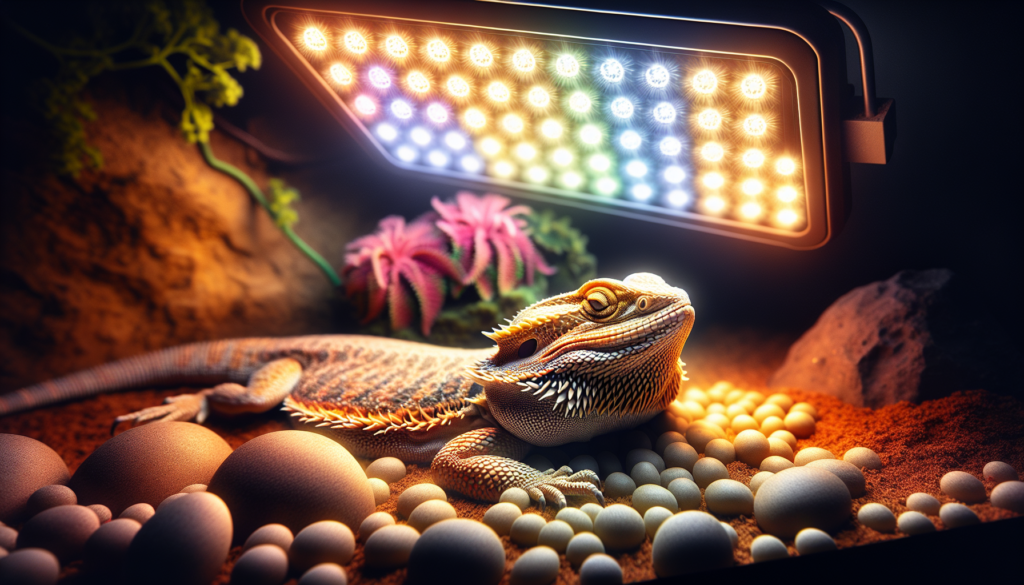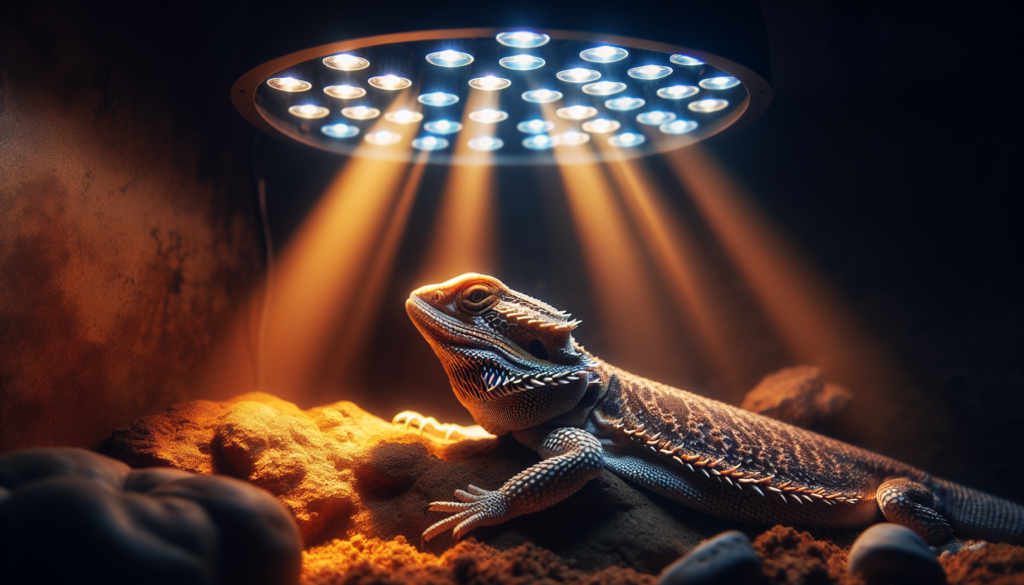Are you a proud owner of a bearded dragon? If so, you probably know that providing the right lighting is crucial for their health and well-being. That’s why the introduction of LED light for bearded dragons has been a game-changer for reptile enthusiasts everywhere. With their energy efficiency and customizable settings, these LED lights mimic the natural sun rays that your beardie needs to thrive. In this article, we will uncover the benefits of LED lighting for bearded dragons, ensuring that your scaly friend receives the best care possible.

Choosing the Right LED Light
When it comes to choosing the right LED light for your bearded dragon, there are a few important factors to consider. These factors will ensure that you provide your reptile with the best possible lighting setup to support their health and well-being.
Factors to Consider
-
Light Intensity: Bearded dragons require a specific amount of light intensity to thrive. It is crucial to select an LED light that can meet their needs. Look for lights with a higher intensity that can mimic natural sunlight.
-
Light Spectrum: The spectrum of light emitted by the LED light is essential for your bearded dragon’s overall health. A balanced spectrum that closely resembles natural sunlight is ideal. This will provide your reptile with the necessary UVB and UVA rays for proper calcium metabolism and vitamin D synthesis.
-
Energy Efficiency: LED lights are known for their energy efficiency. Opting for energy-efficient LED lights not only helps you save on electricity bills but also benefits the environment.
Types of LED Lights
There are several types of LED lights available in the market, each offering unique features and benefits. Here are a few commonly used types:
-
Full-Spectrum LED Lights: These lights are designed to provide a complete spectrum of light, including UVB and UVA rays. Full-spectrum LED lights are an excellent choice for replicating natural sunlight and promoting optimal reptile health.
-
UVB LED Lights: Specifically designed to emit UVB rays, these lights are crucial for bearded dragons as they aid in calcium absorption. This type of LED light is usually used in conjunction with other light sources to ensure a balanced lighting setup.
-
Spotlight LED Lights: Spotlight LED lights are great for creating basking spots within the enclosure. These lights produce focused beams of light, allowing your bearded dragon to regulate their body temperature effectively.
Benefits of LED Lights
LED lights offer numerous benefits when it comes to providing lighting for your bearded dragon:
-
Energy Efficiency: LED lights use significantly less energy compared to traditional lighting options. This means you can keep your reptile’s enclosure well-lit without worrying about high energy costs.
-
Longevity: LED lights have an impressive lifespan, often lasting much longer than traditional bulbs. By choosing LED lights, you’ll save money in the long run by not needing to replace them as frequently.
-
UVB and UVA Output: LED lights designed for reptiles can provide the necessary UVB and UVA rays for your bearded dragon’s health. These rays are essential for proper calcium metabolism, vitamin D synthesis, and overall well-being.
-
Adjustable Color Temperature: Some LED lights allow you to adjust the color temperature, enabling you to create a lighting setup that mimics various times of the day and promotes natural behaviors in your bearded dragon.
Creating the Optimal Lighting Setup
Once you’ve chosen the right LED lights for your bearded dragon, it’s crucial to create an optimal lighting setup in their enclosure. This involves proper placement of the lights, considering temperature and UVB requirements, and setting up a light schedule.
Proper Placement of LED Lights
To provide the best lighting for your bearded dragon, consider the following placement tips:
-
Basking Spot: Place a spotlight LED light above a basking spot in the enclosure. This will create a warm area where your bearded dragon can regulate its body temperature and absorb necessary UVB rays.
-
UVB Coverage: Ensure that your bearded dragon’s entire enclosure receives proper UVB coverage. Position the LED light or lights so that they extend throughout the entire habitat, including any climbing areas or hiding spots.
-
Avoiding Shadows: Be mindful of any objects or structures in the enclosure that may cast shadows and block the light. Position the LED lights in a way that ensures there are no significant shadows that could prevent your bearded dragon from receiving proper lighting.
Temperature and UVB Requirements
Bearded dragons have specific temperature and UVB requirements that must be met to keep them healthy. Here are some important guidelines to follow:
-
Basking Temperature: The basking spot should reach a temperature of around 95 to 105 degrees Fahrenheit (35 to 40 degrees Celsius). This can be achieved by placing a spotlight LED light directly above the basking area.
-
UVB Exposure Time: Bearded dragons require UVB exposure for approximately 10 to 12 hours per day. This ensures they receive enough UVB rays for proper calcium absorption and bone health. Use a LED light that emits UVB rays and set up a light schedule accordingly.
Setting Up a Light Schedule
Establishing a consistent light schedule for your bearded dragon is essential for their well-being. Here’s a basic light schedule to follow:
-
Daytime Lighting: During the day, provide your bearded dragon with full-spectrum LED lighting for approximately 12 to 14 hours. This mimics natural daylight and promotes regular activity and feeding.
-
Nighttime Lighting: Bearded dragons require a period of darkness to simulate natural day-night cycles. Ensure there is complete darkness in the enclosure for approximately 10 to 12 hours to allow your reptile to rest and sleep.
Installing and Maintaining LED Lights
Proper installation and maintenance of LED lights are crucial to ensure they function effectively and provide the necessary lighting for your bearded dragon.
Installing LED Lights in the Enclosure
Follow these steps to install LED lights in your bearded dragon’s enclosure:
-
Safety First: Before installing any lighting fixtures, make sure the enclosure and your hands are clean to minimize the risk of contamination.
-
Secure Mounting: Use the provided mounting hardware or fixtures to securely attach the LED lights to the enclosure. Ensure they are positioned according to the guidelines mentioned earlier.
-
Wiring and Power: Connect the LED lights to a power source using the provided wiring or connectors. Be sure to follow the manufacturer’s instructions for proper setup and wiring.
Cleaning and Replacement
Regular cleaning and periodic replacement of LED lights are necessary to maintain their efficiency and ensure your bearded dragon receives adequate lighting.
-
Cleaning: Clean the LED lights regularly with a soft cloth or sponge. Avoid using harsh chemicals or abrasive materials that could damage the lights. Regular cleaning helps remove dust and debris that may accumulate on the light surface.
-
Replacement: LED lights have a long lifespan, but they will eventually degrade over time. Follow the manufacturer’s recommendations for replacement intervals, usually every 12 to 18 months, to ensure your bearded dragon receives optimal lighting.
Common Mistakes to Avoid
To provide the best lighting setup for your bearded dragon, be mindful of these common mistakes:
Using Incorrect LED Light Colors
Choose LED lights that provide the appropriate spectrum for bearded dragons. Using lights with incorrect color temperatures or lacking UVB output can negatively impact your reptile’s health.
Neglecting Regular Maintenance
Regular cleaning and maintenance of the LED lights are crucial. Neglecting this can lead to decreased light output and potentially harmful effects on your bearded dragon’s health.
Poor Placement of Lights
Ensure the LED lights are positioned correctly to provide the optimal lighting coverage throughout the enclosure. Poor placement can result in inadequate UVB exposure or insufficient heat for basking.

FAQs about LED Lights for Bearded Dragons
Here are answers to some frequently asked questions about using LED lights for bearded dragons:
What are the benefits of using LED lights for bearded dragons?
LED lights offer numerous benefits, including energy efficiency, long lifespan, and the ability to provide the necessary UVB and UVA rays for your bearded dragon’s health.
Can LED lights be used as a sole heat source?
While LED lights can provide some heat, they are not typically sufficient as a sole heat source for bearded dragons. It is essential to provide a separate heat source, such as a heat lamp or ceramic heater, to ensure your reptile’s basking spot reaches the appropriate temperature.
Are all LED lights suitable for bearded dragons?
Not all LED lights are suitable for bearded dragons. It is crucial to choose LED lights specifically designed for reptile use, offering the necessary spectrum, UVB output, and intensity required for the health of your bearded dragon.
Conclusion
Choosing the right LED lights for your bearded dragon and setting up an optimal lighting system is vital for their overall well-being. Consider factors such as light intensity, spectrum, and energy efficiency when selecting LED lights. Proper placement, temperature considerations, and a consistent light schedule ensure your bearded dragon receives the necessary UVB and UVA rays. Regular maintenance and avoiding common mistakes will keep your LED lights functioning effectively. Remember to choose LED lights designed for reptiles and follow the guidelines to provide your bearded dragon with the best possible lighting setup.
